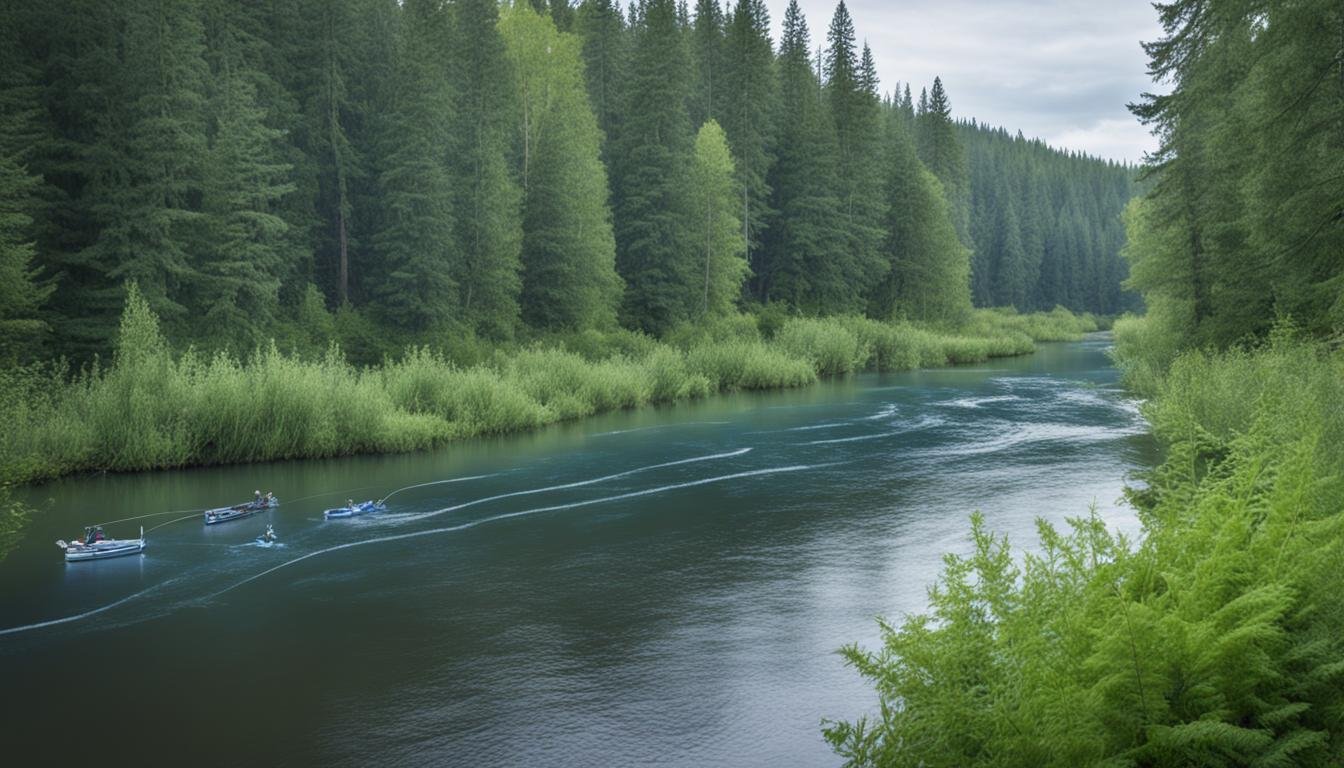Are you missing out on excellent walleye fishing? Walleye fishing enthusiasts know timing is crucial for catching these prized game fish.
Each spring, walleye begin spawning when temperatures rise. Anglers aware of this walleye fishing tip can seize exceptional fishing openings.
Key Takeaways about Fishing During Walleye Spawning
- Walleye spawn when waters reach 6°C to 9°C.
- They migrate to shallow, rocky rivers and creeks.
- After spawning, larger females move deeper while males stay shallow.
- Targeting spawning areas with live bait increases success.
- Understanding spawning behavior is key for spring fishing.
Introduction to Walleye Fishing in Canada
Walleye is a freshwater fish species sought after by anglers across North America. In Canada, walleye offer an exciting and rewarding fishing experience in numerous lakes, rivers, and ponds.
Known for their excellent taste and fighting spirit, walleye make for a thrilling catch.
Characteristics and Habitat of Walleye
Walleye are recognizable by their olive-green or yellowish-brown coloration with gold flecks along the sides. They have white bellies and distinctively large eyes that glow in the dark.
Walleye typically grow to lengths of 25-30 inches and weigh between 6-10 pounds. However, some impressive specimens can reach over 30 inches and weigh up to 20 pounds.
These predatory fish thrive in cool, clear walleye habitat near structures like weed beds, rocks, and drop-offs.
Popularity and Accessibility of Walleye Fishing
Walleye fishing enjoys immense popularity among anglers in Canada and the United States. The fish’s excellent taste and fighting ability contribute to its appeal.
With walleye found in numerous popular walleye fishing spots across Canada, this angling pursuit remains highly accessible. Some renowned best walleye fishing locations include Lake Winnipeg, Lake of the Woods, the Saskatchewan River system, Georgian Bay, Great Slave Lake, and Oak Lake.
- Lake Winnipeg in Manitoba
- Lake of the Woods on the Ontario-Manitoba border
- The Saskatchewan River system
- Georgian Bay in Ontario
- Great Slave Lake in the Northwest Territories
- Oak Lake on the remote English River System in northwestern Ontario
| Location | Average Walleye Size | Notable Trophy Sizes |
|---|---|---|
| Canada (general) | 2-3 pounds | Up to 30 inches, 20 pounds |
| Oak Lake Lodge | Up to 10 pounds | 22.3-pound walleye caught in 2012 |
| Lake Winnipeg | Over 10 pounds | – |
| Saskatchewan River | Over 30 inches | – |
Best Locations for Walleye Fishing in Canada
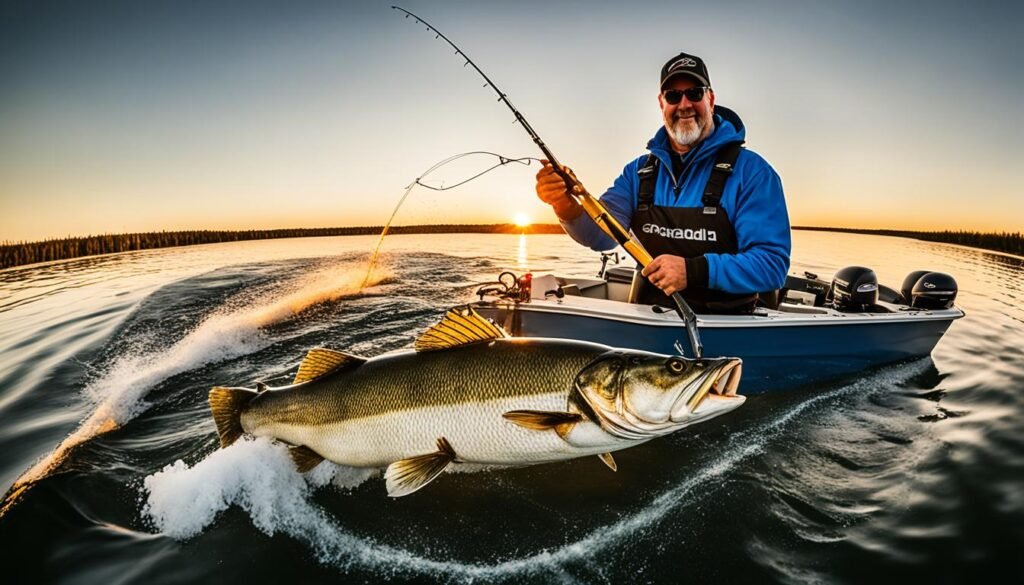
Canada has numerous destinations for walleye fishing enthusiasts. From Manitoba’s Lake Winnipeg to Ontario’s Georgian Bay, you can catch trophy-sized walleye.
Lake Winnipeg
Lake Winnipeg walleye fishing is famous for its abundance. You can catch walleye over 10 pounds here. This massive lake provides ample walleye habitat.
Lake of the Woods
On the Ontario-Manitoba border, Lake of the Woods offers excellent walleye fishing. Techniques like trolling and jigging work well. This lake attracts anglers for its abundant walleye.
Saskatchewan River
The Saskatchewan River produces incredibly large walleye. Fish over 30 inches are common. Anglers come for a chance at catching trophy walleye specimens.
Georgian Bay
In Ontario, Georgian Bay offers great walleye fishing and scenery. You can target other species too. This variety makes it a premier fishing destination.
Oak Lake on the English River System
Oak Lake, in northwestern Ontario, offers excellent walleye fishing. Oak Lake Lodge provides access to 70 miles of untouched waters. Guides help navigate and catch large walleye, up to 22.3 pounds.
Fishing During Walleye Spawning
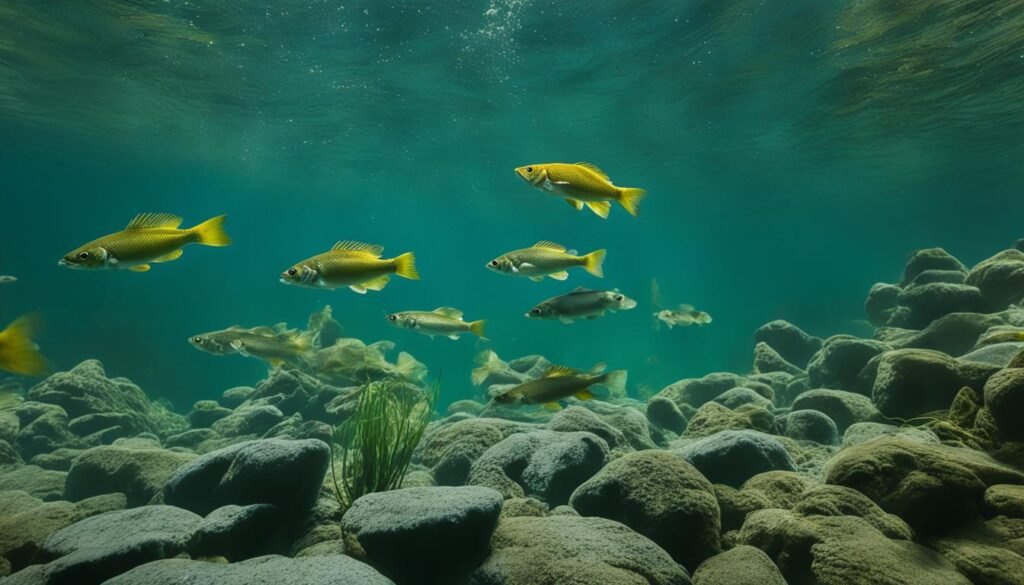
The walleye spawning period is crucial. Understanding their walleye spawning habits is key for successful fishing. When do walleye spawn? Across Canada, spawning occurs from late March to early April.
The exact timing varies by location. Northern regions experience later spawning.
Ideal Water Temperatures for Spawning
Walleyes initiate spawning when temperatures reach around 40°F (4°C). The optimal spawn temps walleye seek are 40°F to 55°F (4°C to 13°C). Spawning usually completes by mid-50s (around 13°C).
In northern Manitoba, the water temperature for walleye spawn is typically mid-40°F (7°C to 9°C).
Spawning Grounds and Migration Patterns
During spawning, walleyes exhibit distinct walleye spawning migration patterns. Areas like Red River, Rainy River, and western Lake Erie host massive spawning migrations. In smaller rivers and lakes, spawning is more dispersed.
Walleye migrate upstream into creeks and rivers, seeking gravel beds. Or move towards shallow rocky shoals in lakes for suitable walleye spawning locations.
Spawning grounds vary greatly in size. From small areas hosting dozens of walleyes to expansive sites attracting thousands. Walleyes often spawn in shallow waters, sometimes less than two feet deep.
Particularly in river channels with current and slack water areas nearby. Hard-bottom river channels and reefs are favorable walleye spawning locations. Females stage off reefs, moving onto them during low-light or egg-dropping.
Local game laws may have specific regulations during walleye spawning. Including restrictions on hook types, bag limits, size limits, nighttime fishing bans, and area closures. These aim to protect vulnerable fish during this critical phase.
Fishing Techniques for Walleye During Spawn
As water temperatures rise early spring, walleye gear up for spawning. This presents an excellent opportunity for anglers. Adopt the right tactics to maximize success.
Targeting Spawning Grounds
During spawn, walleye congregate in shallow areas. Focus on fishing spawn locations like rocky bottoms and emerging weed beds. River inlets, creek mouths, and rocky shoals are prime spots.
Using a drift boat or wading provides easy access to spawning walleye hotspots.
Lures and Bait for Spawning Walleye
For best lures, use smaller offerings mimicking young baitfish. Popular choices include white jig heads with salted minnows, 3-4 inch twister tail grubs in natural colors, flukes in baitfish hues, and shallow diving crankbaits.
Live bait like minnows, nightcrawlers, and leeches are proven walleye spawn bait options.
| Lure Type | Recommended Size | Color Patterns |
|---|---|---|
| Jig Heads | 1/16 – 1/8 oz | White, Chartreuse |
| Twister Tails | 3-4 inches | Natural Baitfish, Green Pumpkin |
| Crankbaits | 2-4 inches | Gold, Silver, Purple, Pink |
Experiment and adapt when fishing spawning walleye. Water conditions and light levels influence behavior and feeding patterns. Switch up presentations and walleye spawn bait to trigger strikes.
Tips for Spring Walleye Fishing
As water temperatures rise, walleye enthusiasts anticipate exciting angling opportunities. This season brings unique challenges and rewards when finding spring walleye. Success depends on proper spring walleye fishing gear and understanding walleye behavior during spawning.
Gear and Equipment
For spring walleye fishing, use a sensitive 6-foot spinning rod. This length allows longer casts with lightweight walleye fishing rod reel setups, presenting baits and jigs effectively. Pair your rod with 4-6 lb test line and 1/16 oz jig for depths around 15 feet where walleye congregate pre-spawn and spawning.
A quality fish finder helps locate walleye schools and identify depth changes they relate to.
Locating Areas of Activity
In spring, walleye gravitate towards areas providing cover and ideal spawning conditions. Spring walleye locations include emerging weed beds, drop-offs, points, and rocky areas in 4-15 feet of water. They’re most active around dawn and dusk when light levels are lower.
Utilize your electronics to locate depth and structure changes that may hold fish, increasing your chances of success.
Live Bait versus Artificial Lures
For walleye bait vs lures during spring, both can be highly effective depending on conditions. Live bait like minnows and nightcrawlers can be irresistible. However, artificial lures like jigs tend to be productive right after spawning.
On cloudy, windy days, crankbaits and other reaction baits can trigger strikes. Experiment with live bait and artificial offerings to determine what walleye are responding to.
| Bait Type | Pros | Cons |
|---|---|---|
| Live Bait | Natural presentation, highly attractive | Limited casting distance, shorter life |
| Artificial Lures | Long-lasting, cover more water efficiently | Less natural presentation, require finesse |
With the right gear, understanding where to find walleye, and versatility with bait and lure choices, you’ll capitalize on the exciting spring opportunities.
Summer Walleye Fishing Strategies
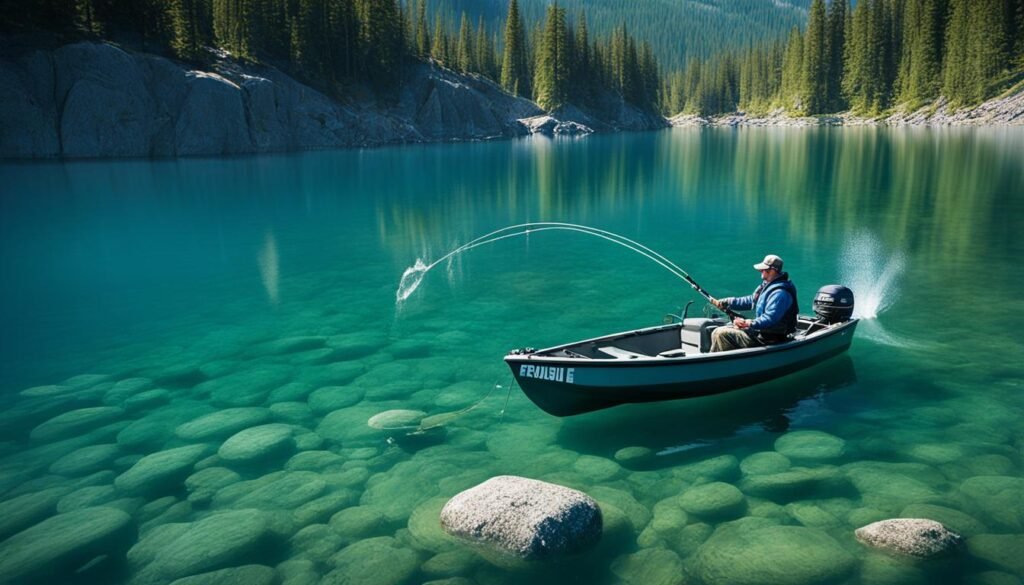
As summer weather arrives, walleye move from shallow spawning areas. They go to deeper, cooler waters in the main lake basins. Targeting spots like points, humps, and drop-offs in 15-30 feet is productive. Use live bait rigs or crankbaits that reach summer walleye depths.
Trolling deep-diving crankbaits is also a proven way to catch walleye summer. This technique works on many lakes.
Walt Matan, an experienced angler, emphasizes location matters for summer walleye tactics on rivers. Fish react differently across river systems. He suggests using specific baits like the BFishNTackle Draggin’ Jig. Also use plastics such as AuthentX Moxi. The 1/4-ounce Draggin’ Jig is versatile for fishing river wing dams.
Matan recommends gear like the St. Croix Eyecon Snap Jig rod. Use 10-pound Fireline braid, and Daiwa Tatula LT 3000 reel for catching walleye summer in rivers. His preferred jig and plastic colors include white, gold, orange, chartreuse, and sour apple.
Side Imaging technology identifies fish and structures in river systems. This is crucial. Techniques like ripping hair and using jigs with fatheads work for catching walleye summer in rivers. Match the hatch.
Matan stresses jig weight and color selection importance. Color can significantly impact walleye fishing success.
In summer, fish early mornings or late afternoons/evenings to avoid midday heat and sun. River walleye show different seasonal behavior, but summer walleye tactics still offer good opportunities.
| Factor | Summer Walleye Fishing |
|---|---|
| Depth | 15-30 feet |
| Structure | Points, humps, drop-offs |
| Presentation | Live bait rigs, crankbaits, trolling |
| Best Times | Early morning, late afternoon/evening |
Fall Walleye Fishing Tactics
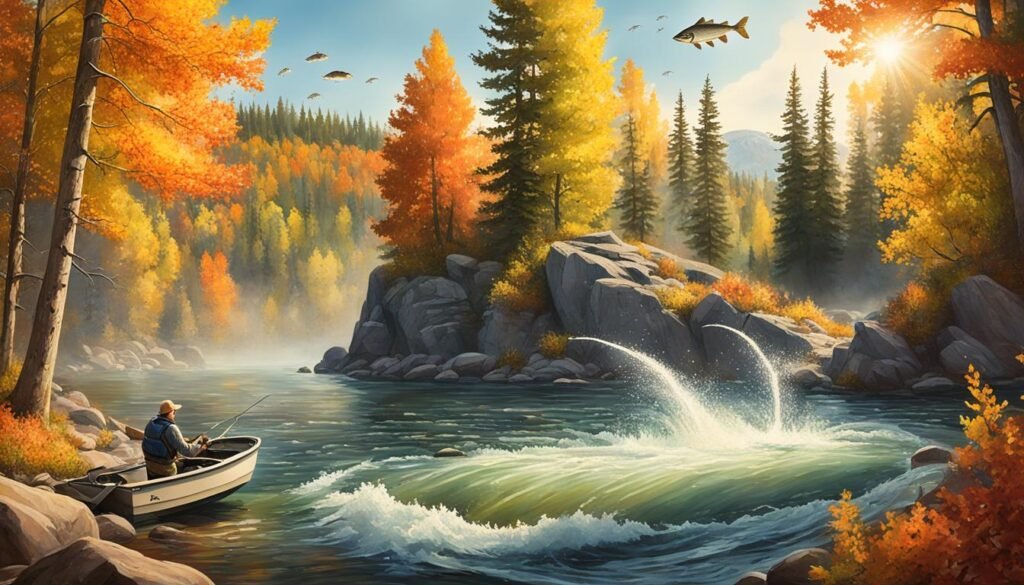
As summer heat decreases, walleye experience changes in fall walleye feeding behavior. This period gives anglers excellent fall walleye fishing tips and distinct autumn walleye patterns.
Cooler Water Temperatures
Fall’s arrival signals walleye to build fat reserves for winter months. Increased feeding activity from cooler water temperatures creates an exceptional walleye bite fall season.
Around mid-August in northern regions, browning weeds make walleye migrate to shallower areas like points, flats, and shoreline structures. Diminishing light and cooler waters make them comfortable in skinny depths.
Transitioning Feeding Patterns
During this fall transition period, walleye may relate to deeper summer haunts in morning and evening, but actively move into shallower waters to feed during the day. Anglers should adjust tactics, targeting different depths based on time of day and weather.
This transitional phase lets anglers intersect increasingly active, roaming walleye following baitfish migrations. Some walleye may temporarily move up-lake, closer to spawning areas for the following spring.
| Fall Walleye Behavior | Angling Tactics |
|---|---|
| Bulking up for winter | Use bigger baits like 4.5-inch swimbaits and 5- to 7-inch minnows |
| Baitfish migrations | Target rocky shorelines, points, and structures where bait congregates |
| Spawning area run | Focus on areas near future spawning grounds like rivers and creek mouths |
| Vertical movements | Fish steep drop-offs and structures that allow walleye to move vertically |
In cisco lakes, minnow migrations stimulate major walleye feeding on abundant food. Night fishing with stickbaits and crankbaits is effective when walleye’s low-light vision shines.
Regulations and Limits for Walleye Fishing in Canada
Following Canadian walleye fishing rules and walleye limits is crucial for responsible anglers. These regulations protect fish populations and ensure fair access to resources.
Across Canada’s twenty fisheries zones, walleye fishing season dates, catch limits, and size restrictions vary. Anglers should obtain licenses and know the rules before fishing.
Regulations differ based on license type, like sport or conservation fishing. Certain practices like culling are permitted under specific conditions for walleye, pike, and bass.
- Size limits protect immature fish.
- Anglers must release oversized or excess catches.
- Catch and release guidelines minimize handling stress.
- Regulations mandate releasing protected species.
In Ontario’s Zone 10, new walleye rules take effect in 2024. The season runs January 1 to mid-March, and mid-May to December 31.
| Regulation | Details |
|---|---|
| Walleye Fishing Limits | S-4 (Sport) and C-2 (Conservation) |
| Size Restriction | No walleye over 46 centimeters allowed |
| Previous Allowance | Removal of the option to keep one walleye over 46cm within the legal limit of 4 fish |
These changes address declining walleye populations in Zone 10, where adult numbers have fallen unsustainably low, per the Ministry of Natural Resources and Forestry.
Sustainable Practices and Conservation Efforts
Across Canada, walleye conservation and promoting sustainable walleye fishing are top priorities. Several practices play a crucial role in preserving healthy walleye populations. These include carefully releasing spawning females, selective harvest of males, and strict adherence to quotas.
Many regulations aim to protect critical spawning areas when walleye are vulnerable. For example, Lake Erie regulations included catch limits, size restrictions, and closed seasons for spawning grounds. These efforts, coupled with hatcheries raising walleye fingerlings, contributed to Lake Erie’s walleye recovery.
The restored walleye fishery boosted tourism and the local economy. However, walleye conservation Canada efforts require continued monitoring and strategies to address environmental concerns threatening Lake Erie’s ecosystem.
Collaboration among agencies, scientists, anglers, and stakeholders ensures long-term sustainable walleye fishing success in Canada.
In Alberta, Fisheries Management uses the Fish Sustainability Index (FSI) to score historic adult density and inform fish population sustainability. Despite having around 800 fish-bearing lakes, Alberta reported nearly 352,472 anglers, with nearly 100 times more angling pressure per waterbody than other provinces.
| Province | Number of Fish-Bearing Lakes | Estimated Number of Anglers | Angling Pressure per Waterbody |
|---|---|---|---|
| Alberta | 800 | 352,472 | Nearly 100 times more than other provinces |
According to the FSI, most Walleye and Northern Pike populations in Alberta remain at high to very high sustainability risk. New frameworks aim to recover and maintain these populations while reducing sport fishing regulation complexity.
For Lake Erie, the Lake Erie Committee oversees management of species like the economically significant Walleye. The Lake Erie Walleye Management Plan includes performance indicators from 2005-2012, while the Fish-Community Goals and Objectives guide fishery management for all agencies.
- Walleye population assessment and management in Lake Erie are divided into five Management Units (MUs).
- Research maintains genetic diversity and identity of locally adapted Walleye stocks.
- Sustainable Walleye harvest and genetic diversity maintenance are key objectives.
Conclusion
Understanding walleye behaviors and movements is crucial for successful fishing in Canada. During spawning, target shallow rocky areas and weed beds. Use live bait or small swimming lures.
As summer arrives, walleye move to deeper, cooler zones. Employ offshore tactics and deeper-diving baits to target them.
Cooling autumn temperatures trigger increased walleye feeding before winter. This transition offers exceptional fishing opportunities for anglers adjusting tactics accordingly.
Practice catch-and-release on spawning females and follow regulations. This ensures future generations can enjoy world-class walleye fishing across Canada.
Focus on prime areas, use effective lures and tactics, and responsibly release fish. These are keys to unlocking rewarding walleye angler experiences on Canadian waters.
By understanding walleye spawning behaviors, movements, and productive techniques for each season, anglers can consistently enjoy exceptional walleye fishing in Canada.
FAQ about Fishing During Walleye Spawning
What are the distinguishing characteristics and preferred habitat of walleye?
Walleye are freshwater fish found across North America. They grow up to 25-30 inches and weigh 6-10 pounds. They have olive-green or yellowish-brown coloring with gold flecks. They have white bellies and large eyes that glow. Walleye prefer cool, clear waters near structures like weedbeds.
Where are some of the top walleye fishing destinations in Canada?
Top walleye fishing spots in Canada include Lake Winnipeg, Lake of the Woods, Saskatchewan River, Georgian Bay, Great Slave Lake, and Oak Lake. These areas are known for abundant walleye populations and trophy-sized fish.
When is the walleye spawning season and what conditions are ideal for spawning?
Walleye spawn in spring when water is 6°C to 9°C. They migrate to shallow waters like rivers and rocky shoals. In northern regions, they may skip spawning if preferred temps aren’t reached.
What fishing techniques and baits are effective for targeting walleye during the spawn?
Target shallow spawning grounds with weedbeds and rocky bottoms. Use smaller lures mimicking baitfish like jig heads with minnows, twister tails, and crankbaits. Live bait like minnows, nightcrawlers, or leeches work well.
What gear is recommended for spring walleye fishing?
Use a 6-foot sensitive spinning rod to cast lightweight baits and jigs. Pair with 4-6 lb test line and 1/16 oz jig. A fish finder helps locate walleye and depth changes.
How do walleye fishing patterns change in summer and fall?
In summer, walleye move to deeper, cooler main lake basins. Target 15-30 feet depths with live bait rigs or crankbaits. In fall, they move shallower and feed aggressively before winter.
What regulations should walleye anglers be aware of in Canada?
Walleye anglers must understand regulations like catch limits, size restrictions, and seasonal closures. Rules vary across provinces and lakes. Obtain proper licenses and check current rules.
Why are sustainable practices and conservation efforts important for walleye fishing?
Promoting sustainable walleye fishing and conservation preserves healthy populations. Key practices include releasing spawning females, selective harvest of males, and adhering to quotas.
Source Links
- https://www.oaklakelodge.com/walleye-fishing-in-canada-most-important-facts-and-information
- https://www.wired2fish.com/walleye/how-to-catch-walleye-best-walleye-fishing-tips
- https://www.mycanadafishingtrip.com/canada-fishing-info/page/walleye
- https://truenorthwilds.com/spring-walleye/
- https://www.outdoorcanada.ca/a-guide-to-fishing-post-spawn-walleye/
